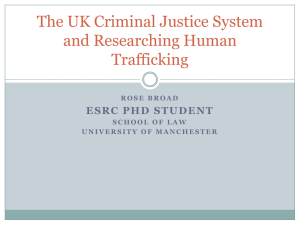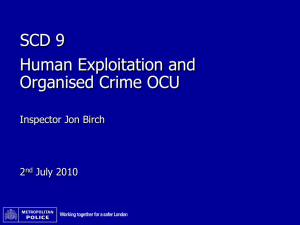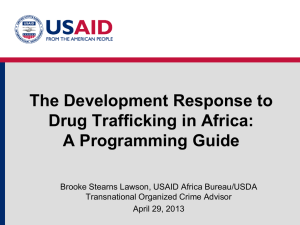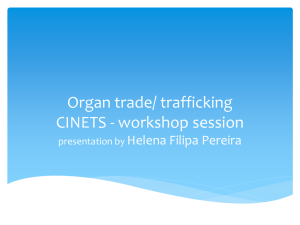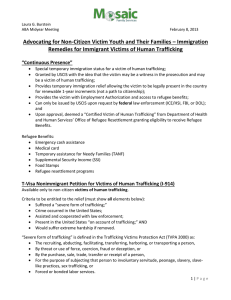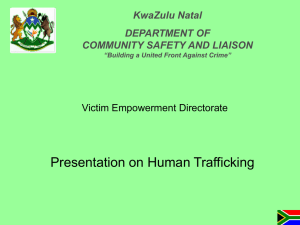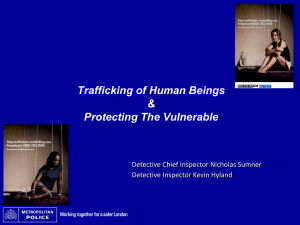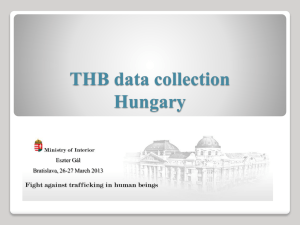Case Management (3) - Capacity Building Workshop
advertisement
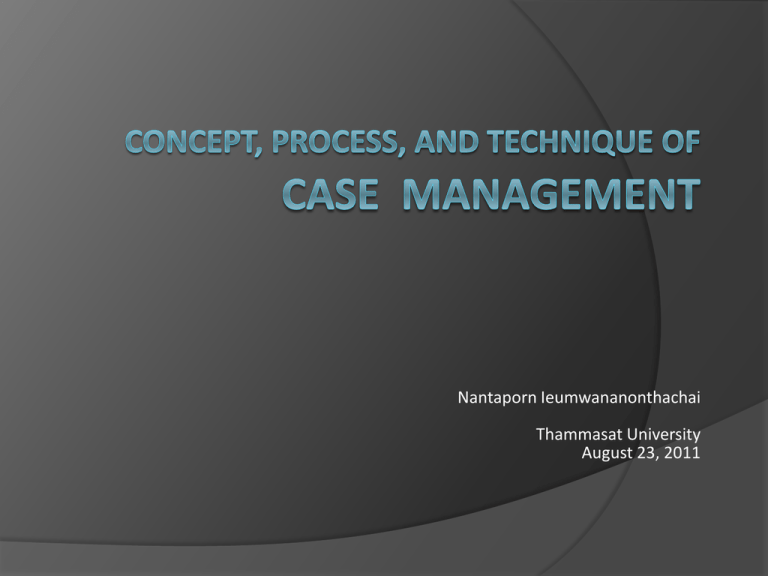
Nantaporn Ieumwananonthachai Thammasat University August 23, 2011 Case Management is … a collaborative process of assessment, planning, facilitation and advocacy for options and services to meet an individual’s holistic needs through communication and available resources to promote quality cost-effective outcomes. (Case Management Society of Australia 2009) a process for assessing the client’s total situation and addressing the needs and problems found in the assessment. (Summers, 2009) History Case management emerged as a separate and professional service in the 1970s, where it was seen as a way to connect clients with multiple needs to an increasingly complex social service delivery system (Turner & TenHoor, 1978). Throughout its history, case management has focused on the holistic needs of clients, addressing basic needs such as safety, food, and shelter, as well as emotional, medical, and other needs including employment, education, and connection with others in the community (Rapp, 1998) Advancement of Sciences, Technologies, and Medicine “Holistic Interdisciplinary” concept “Individualized Human Right” concept Cross border issues Complex social situation and problems Organization mandate is not consistent with responses required Limitation on quality and access of services CM Limitation of resources and services Globalization and Gap in Economic Development Require intensive coordination Questions? Do you know any two person who have the same exact background? Would it possible for two person to have the same exact problem (with exact same details)? Would it possible for two person to have the same preference? Would it appropriate to solve problem of two people with different background, different strengths, different preference, using the same solution? Principles of Case Management The service delivery is individualized based on comprehensive assessment that is used to develop a case or service plan Questions? Who own the problem? Who should work on the problem? Let client work on the problem with your support CM is an expert on available services and system But client is an expert on his/her own life. Principles of Case Management The service delivery is individualized based on comprehensive assessment that is used to develop a case or service plan The plan is developed in collaboration with the client and reflects their choices and preferences for the service arrangements being developed The goal is to empower the client and ensure that they are involved in all aspects of the planning and service arrangement in a dynamic way. (Case Management Society of Australia 2009) Multiple services are provided to individual in a holistic approach with case manager as main coordination mechanism through multidisciplinary team and case conference Human Trafficking The United Nations definition of Human Trafficking is “The recruitment, transportation, transfer, harbouring or receipt of persons, by means of the threat or use of force or other forms of coercion, of abduction, of fraud, of deception, of the abuse of power or of a position of vulnerability or of the giving or receiving of payments or benefits to achieve the consent of a person having control over another person, for the purpose of exploitation” Advancement of Sciences, Technologies, and Medicine “Holistic Interdisciplinary” concept “Individualized Human Right” concept Cross border issues Complex social situation and problems Organization mandate is not consistent with responses required Limitation on quality and access of services CM Limitation of resources and services Globalization and Gap in Economic Development Require intensive coordination CRISIS INTERVENTION Medical treatment physical examination and treatment psycho and emotional support Legal assistance - law enforcement Legal advice Legal support Investigation and proceedings Social services Crisis measures - inc. temporary care Complete assessment (incl. risk) Planning Rehabilitation: Prevention of further harm Restriction/protection orders Permanency planning and monitoring Family support services (economic, mediation, social skills, housing, employment, social services…) psychological and emotional support support during and after legal proceedings advocacy and referral to existing services Coordination/ Linkages Health Personnel Therapist Community workers Psychologist CM Families Social Worker Police Other Professionals Case Management definition in work with victims of trafficking "a collaborative means of helping people who are disadvantaged or devalued in society, to discover their strengths and personal power, pursue their own objectives, and begin to confront the systems that oppress them, in order to redistribute power and thereby improve their life chances and quality of life" (Spindel, 2008, p.15). Coordination/ Linkages Health Personnel Therapist Community workers Psychologist CM Families Social Worker Police Other Professionals Case Management is one of the services delivery approach The Case Management approach assumes that clients with complex and multiple needs will access services from a range of service providers and the goal is to achieve seamless service delivery. This assumption highlights that the concept of Case Management is based in service provision arrangements that require different responses from within organisations and across organisational boundaries. Case management is described as a boundary spanning strategy to ensure service provision is client rather than organisationally driven. (Case Management Society of Australia 2009) Components of Case Management Process Identification / Selection Termination Evaluation Assessment Client Implementati on/ Coordination Planning Standards of Practice for Case Management, revised 2010 (USA) 1. Client Identification and Selection Focus on identifying clients who would benefit from case management services. Standards of Practice for Case Management, revised 2010 (USA) 2. Assessment and problem/ opportunity identification: Begin after the completion of the case selection and intake into case management and occurs intermittently, as needed, throughout the case. (Standards of Practice for Case Management, revised 2010 (USA)) What do we need to know from assessment? Exploring and evaluating initial problem and the background, person’s current situation, person’s background, what the person needs to make life more stable and to resolve current problem, and strengths of person and environment (Summers, 2009) 3. Development of the Case Management Plan Establish goals of the intervention and prioritizes the client’s needs, as well as determines the type of services and resources that are available in order to address the established goals or desired outcomes. Standards of Practice for Case Management, revised 2010 (USA) 4. Implementation and coordination of care activities Put the case management plan into action through the coordination with service providers, and client and family. If the client has to be referred, communicate with new provider (CM) and client, and ensure smooth transition. Standards of Practice for Case Management, revised 2010 (USA) Coordination Divide into 3 phases 1. Beginning 2. Network maintenance 3. Termination (Onopas, 2011) Referral 1. 2. 3. 4. 5. 6. Identify objective of the referral, and jointly work with client to select appropriate agency for referral Communicate with destination agency and new CM, to ensure smooth transition Prepare necessary document for referral Prepare client for the transition If the client has to be transferred to another geographical area, ensure that there is someone to accompany the client if s/he is not capable of travelling by him/herself. Follow up on the transition, and evaluate client’s satisfaction. 5. Evaluation of the case management plan and follow-up Involve the evaluation of the client’s status and goals and the associated outcomes. Standards of Practice for Case Management, revised 2010 (USA) 6. Termination of the case management process Bring closure to the care. The process focuses on discontinuing case management when the client transitions to the highest level of function, the best possible outcome has been attained, or the needs/desires of the client change. Standards of Practice for Case Management, revised 2010 (USA) Case Management goals enhancing developmental, problem-solving, and coping capacities of clients linking people with systems that provide them with resources, services, and opportunities creating and promoting the effective and humane operation of systems that provide resources and services to people improving the scope and capacity of the delivery system contributing to the development and improvement of social policy (NASW, 1992) Micro Meso Macro Case Manager is working with Client/ Services User (Micro) Personal context (Meso) Social context: Environment (Macro) Client/service user Individual: with problems that are complex, chronic, severe, repeated, etc. Target group: elderly/ child and youth/ female (with all forms of violence), substance abuser, HIV/AIDS or chronic patients, disable (physical/ mental/ intellectual), perpetrator after being released, those at risk of facing repeated problems, etc. Personal context: Family, work group, social groups, family culture, family values, family structure, religious group, social class, role status – conflict – strain. (Summers 2009) Social context: Environment services system economic and politic culture and belief Assignment Talk to human service professional in your community about what that person sees as an unmet need in the community. What one service relating to human trafficking would the professional like to see developed? What specific need would that service met? What client population would that project address? How could the clients who need this service be mobilized to work in their own behalf? Roles of Case Manager Facilitator (within service system) Advocator (rights holder) Educator Negotiator Coordinator Manager (monitor and follow up on outcomes/ and transition) Attitudes of an effective CM Warmth Genuineness Empathy Profound effect on client’s ability to move forward and heal Self-Assessment exercise (5 minutes) Skills required to be an effective CM Work effectively with people to promote their growth Work with people of various professions, paraprofessionals, the public, and clients and their families Identify what your client needs Keep accurate and well-organized records Allow the client to take leadership in planning services Develop creative resources within your community to meet client needs. Knowledge base for Case Management Individual and family dynamic The relationship between and among social, psychological, physiological, and economic factors The focus and policies of your agency Government regulations that affect your agency’s delivery of service The vast array of community services and resources where you practice. Guidelines for Case Management Plan ahead (prevent crisis) Be accountable Be optimistic Involve your clients Go where your clients are Promote independence Develop a large number of resources Assignment Put together a resource book listing agencies and what they do, support groups, and places where educational seminars and workshops are held for the general public. Collect them from the community where you expect to practice, and keep the latest copy of social services agencies found in most telephone books. Sample Tools for CM Bio Psycho Social Assessment Strength Based Assessment Life Plan Contract Plan (Task Plan) Case Conference/ Multidisciplinary meeting Team A team or group consisting of representatives from several different professional backgrounds who all have different areas of expertise. (http://society.guardian.co.uk/glossary/p) A group of professionals from diverse disciplines who come together to provide comprehensive assessment and consultation in abuse cases (http://wiki.answers.com/Q/What_is_the_meaning_of_the_term_multidis ciplinary_team#ixzz1UzV0oQFy) Coordination/ Linkages Health Personnel Therapist Community workers Psychologist CM Families Social Worker Police Other Professionals Why a multidisciplinary approach? Deal with complicated problems Provide diverse and overall aspect on particular issue Provide opportunity to see from different angles/ professional perspectives Allocate work among agencies Reduce duplication of work Multidisciplinary team meeting A meeting consist of many professionals vs. Case Conference A meeting for a particular case Multi Disciplinary Case Conference (MDCC) For Child Protection (Abuse) case, MDCC is a forum by which professionals having a major role in the handling and investigation of a suspected child protection case can share their professional knowledge, information and concern on the child health, development, functioning and his/her parents’/carers’ ability to ensure safety of the child. Focus on protection and welfare of the child and not prosecution of the abuser. Analyzes risks and recommends actions to be taken in relation to the welfare planning of the child and his/her family, respecting the statutory obligations of individual members for the case. (from: www.swd.gov.hk/doc/fcw/proc_guidelines/childabuse/Chapter11.pdf) Objectives of case conference Discussion of the clients history Identification of the clients multi-disciplinary needs Identification of outcomes to be achieved by members of the team providing services to client Identification of tasks to be undertaken to achieve outcomes and allocation of tasks to team members Assessment of success or otherwise of previously identified outcomes (adapted from http://www.gpageelong. com.au/Our-Services/Medicare/case-conferencing.html) Samples of roles of CM for Trafficking victim (US) In addition to serving as a single point of contact, a central case manager can assess a client's need for services and support; identify, obtain, and coordinate those services for the client; coordinate and manage communications across systems; and serve as a liaison for the client. Other functions of the case manager include: translating for the victim or obtaining translation services; accompanying clients to appointments; assisting/teaching clients to access public transportation; and in some cases, teaching clients basic life skills. Sometimes this includes teaching clients how to use kitchen appliances or how to make a phone call. Offering reassurance and comfort to clients often occupies much of a case manager's time, but it is essential in building trust and rapport with the client. In fact, many providers and law enforcement representatives note that the case mangers are often the first and sometimes the only person a victim trusts. From: Case Management and the Victim of Human Trafficking: A Critical Service for Client Success By: Heather J. Clawson and Nicole Dutch , June 2008 Ingredients for Effective CM in Human Trafficking Establishing a hopeful relationship with the client; Assessing client strengths and needs; Developing, in partnership with the client, a service plan to achieve desired outcomes; Locating, linking, and following up with needed services and support; Monitoring, coordinating, and adjusting services and supports to achieve desired outcomes; Providing crisis prevention and intervention services and support; and Advocating for the client. Extracted from the NACM Web site, http://www.yournacm.com/definition.html The effectiveness of any case management program depends upon the availability of highquality treatment and support services in a given community, the structure and coordination of the service system, and on the ability of an individual or family to pay for care either through private insurance or (more often) through public benefit and entitlement programs. From: Case Management and the Victim of Human Trafficking: A Critical Service for Client Success By: Heather J. Clawson and Nicole Dutch , June 2008
